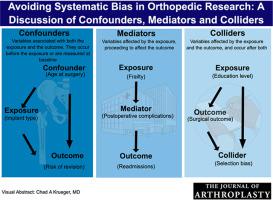The Journal of Arthroplasty ( IF 3.4 ) Pub Date : 2022-09-06 , DOI: 10.1016/j.arth.2022.05.027 Katrina L Devick 1 , Isabella Zaniletti 1 , Dirk R Larson 2 , David G Lewallen 3 , Daniel J Berry 3 , Hilal Maradit Kremers 4

|
There are 3 common variable types in orthopedic research—confounders, colliders, and mediators. All 3 types of variables are associated with both the exposure (eg, surgery type, implant type, body mass index) and outcome (eg, complications, revision surgery) but differ in their temporal ordering. To reduce systematic bias, the decision to include or exclude a variable in an analysis should be based on the variable’s relationship with the exposure and outcome for each research question. In this article, we define 3 types of variables with case examples from orthopedic research. Please visit the following https://youtu.be/V-grpgB1ShQ for videos that explain the highlights of the article in practical terms.
中文翻译:

通过知情变量选择避免骨科研究中的系统偏差:关于混杂因素、中介因素和碰撞因素的讨论1
骨科研究中有 3 种常见的变量类型:混杂因素、碰撞因素和中介因素。所有 3 种类型的变量都与暴露(例如,手术类型、植入类型、体重指数)和结果(例如,并发症、翻修手术)相关,但其时间顺序不同。为了减少系统偏差,在分析中包含或排除某个变量的决定应基于该变量与每个研究问题的暴露和结果的关系。在本文中,我们通过骨科研究的案例定义了 3 种类型的变量。请访问以下 https://youtu.be/V-grpgB1ShQ 观看以实际方式解释本文要点的视频。











































 京公网安备 11010802027423号
京公网安备 11010802027423号